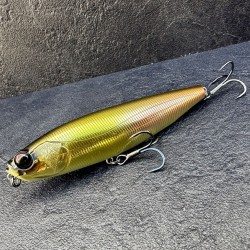Stickbait Lure

Stickbait lure : best topwater floating lure
Stickbait lure : it is a surface lure that is retrieved by the strokes of the rod tip to get the famous walking the dog (WTD) action. The stickbait allows you to fish freshwater predators like pike, perch, black bass but also big chubs. Much like a lipped hardbait, the angler focuses his attention on the surface of the water. One of the best lures for sea bass, in calm weather as long as when the sea is not too rough.
Presentation and swimming mechanics
The first thing you notice about this stickbait is the absence of a lip. It presents a random geometry, from a cylindrical base to an oval one according to the models, its shape hugs perfectly the surface to offer a great action. An efficient weight arrangement provides good casting distance performance. The steel balls are located at ¾ back, in tail. When you pause the stickbait stays in the rest position as if sitting on the water.
The distribution of inner weight, allows the swimming action in walking the dog but also to be able to throw easily even in front of a strong wind. Finally, the position of the line tie is between the chin and the nose according to the models and their geometry.
Long slide and sound
First of all, there is an alternative way to make your stickbait swim other than walking the dog, this technique is called the long slide. It is an ideal retrieve in calm weather at sea for sea bass. In fresh water it is perfect in the absence of pike, perch or black bass visibly chasing. Contrary to the Walking the Dog swim obtained by small and fast strokes of the tip, the long slide offers wider turns.
To achieve this, the lure is pulled gently with the rod tip at intervals. The lure moves in a sinuous "S" shaped swimming pattern, less flashy, more "soft" than the WTD. The steel balls used to balance the lure do not only have any hydro dynamic function but also a noise rattle function. Indeed, the slamming of the steel balls on the ABS wall of the stickbait produces a deep sound which is effective to call the fish from far away.
Some stickbaits offer additional vibrations thanks to small glass, steel or tungsten balls, size 2 to 3 mm. These small balls are called rattles, their role is the production of vibration and sound medium / high frequency. The sound of a stickbait can be an asset as well as a disadvantage. For sea fishing in rough water, weather disturbances weaken the vibrations of the lures. For this reason, a stickbait with a powerful and low sound allows to be quickly located by a sea bass. For freshwater predators, in the absence of wind, it is interesting to use silent stickbaits to offer a natural presentation.
We can try first with a silent model then we alternate with a noisy stickbait. The best way to save time is to have at least two rods mounted within reach to alternate. We prefer fast prospecting with a silent model, in calm weather in absence of visible activity. Otherwise, as soon as you notice the activity of the predators, you alternate with a noisy model.
Every now and then, make a short, quick accelration in the middle of the retrieve to give black bass, perch and pike the impression that the prey is slipping away. It is a good way to get a sluggish fish to strike. In conclusion, to be effective with a stickbait, we alternate the speed of the retrive until we catch the first fish, indicating the right retrieve to use.
Where to fish for freshwater predators with stickbaits?
First of all, it is possible to catch freshwater predators all year round with a stickbait surface lure. You just have to position yourself in the right fishing areas and make sure that the weather conditions are in your favor.
Stickbait For Pike
For pike fishing, although the main season is from May to October, the shallow areas are the most suitable for pike fishing with stickbait. The fishing season is divided in two: cold and warm season.
In the warm season, pike can be found along reed beds in shallow areas, posted on the lookout for prey such as roach and bleak. For pond fishing, pond tails, tree foliage and plant cover are prime areas. It likes vegetal structures such as water lilies, and submerged woods.
It’s a good idea to start with long slide retrive, natural prsentation, along these obstacles, then we move on to a Walking the Dog retrive, more dynamic, in the absence of bites. It is possible to switch from a slow animation to a fast one, by practicing the opposite you run the risk of scaring sluggish/warry fish. For stickbait river fishing, pike are found posted at the end of the current, taking advantage of the oxygen supply.
There can be a feeding frenzy in the morning and evening, which are the times of fishing in the first and last hours of the sun. For the cold season, the best times to fish for pike with stickbaits are the warmest hours of the day. The sun heats up the shallow areas quickly, and you can fish in depths of up to 1 meter, which is ideal in this period.
When the fish strikes, you should delay your hookset by about half a second to wait for the lure to be well in the fish’s mouth, otherwise you will pull the bait out. Refine your presentation with a fluorocarbon leader of sufficient diameter to avoid being cut.
Black bass, perch and chub on stickbait
Black bass and perch are fun to fish with stickbaits, they can be found during the summer months, posted right under the surface or along obstacles such as bridge pilings, submerged wood and vegetal cover.
Chub can be caught with stickbait in the currents and eddies of rivers and streams. This coarse fish, adopts an opportunistic behavior and capable of violent strikes on your lure. With the help of a pair of polarized sunglasses, you can spot the black bass posted around the lily pad. Watch your fishing area carefully, schools of perch often hunt along the banks, rocky outcrops and scree. If you plan to fish by sight, cast your lure with a safe distance from the fish so as not to scare it when it lands.
At this precise moment when black bass or perch quickly approach the lure, two scenarios are possible.
- The fish hits the stickbait at the beginning of the retrieve
- The fish follows the lure and stops its progression at the moment of the pause, turns around the stickbait, understanding that it is a trap.
In these conditions, the idea is to never give the fish time to observe your lure. To do this, fast retrives are recommended. Chub is a coarse fish that also attacks on the impact of the lure, unlike black bass and perch, the landing of a lure arouses its curiosity. In conclusion, the stickbait is a versatile lure that allows you to fish for most game fish in freshwater (pike, perch, black bass, asp) and in the sea (sea bass).



